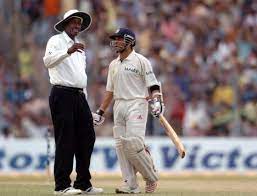
Cricket is a game of discipline as a result of which it’s also known as the Gentlemen’s game. The person responsible to look after the smooth functioning is the Umpire. The cricket field has two onfield umpires: the nonstriker and the square-leg umpire as well as other associate umpires and the match referee which act off-field. But not every time are their decisions welcome by the players and there have been many incidences when umpires decision created many questions and havoc’s among the Cricketing world. So today in this article we will speak about six such most controversial decisions given by the umpire.
The first incidence in the list dates back to the Charlton and United Tri-Series in 1998/99 series played between England, Sri Lanka, and Australia. In the eighth game of the said series between England and Sri Lanka, Muttiah Muralitharan was introduced into the attack. After bowling the fourth ball of the 18th over, umpire Ross Emerson, who was standing at square-leg, decided to call a no-ball on the young off-spinner for ‘throwing the ball’. Muralitharan had been previously called for chucking, and after a lot of adjustments, was cleared by the ICC to continue with his bowling action. On the day, neither umpire Tony McQuillanat the bowler’s end nor either batsman had any complaints with the bowling action or anything.
After enough controversy on the field, the Sri Lankan captain Arjuna Ranatunga asked his teammates to apologize to the English batsman and immediately leave the field. The game had come to an unfortunate but abrupt stop when the associate umpires as well as the match referee had to interfere to sort things out and to persuade the Lankan team to return to the field. It was a moment of infamy for umpire Ross Emerson who seemed to have a problem with Murali’s bowling action. Incidentally, it was quite bizarre for Emerson to have ‘seen’ the throwing motion of the bowler’s arm while standing at square leg.
The second such incident occurred during 1984 in the second test between the formidable Australian side and the Westside. Geoff Lawson was dismissed on account of hit wicket not once, but twice and everyone on the pitch, the ground as well as the commentators noticed but not the two umpired on the field. The first time, Geoff Lawson, while attempting a leg glance, promptly knocked the bails down due to his heels touching the stumps. All that the umpire did was walk up to the stumps and put the bails back on! The crowd was in a sense of shock but considering it as a human error many did not focus on the incident until the next over.
In the very next over Geoff once again similarly tripped the bails and to everyone surprise the umpires once again went and set the bails without the minutest of doubts that the batsman may be out, hit wicket. The opposing captain asked the I pores now the batsman was still on the crease with the nails dislodged but to no avail. Eventually, the incident did not have an impact on the outcome of the game. West Indies won on the day, but the umpire’s decision of not calling the batsman out in both instances was strange, to say the least.
The third instance occurred during 2006 when the two on-field umpires Darrell Hair and Billy Doctrove awarded the game to England via forfeit. In 2006 Pakistan was on a tour of England for four tests, five ODIs, and a single T20I. While the series was already swept by England 2-0, in the fourth and final test, a highly controversial incident occurred. Test. An hour before tea on Day 4, umpire Darrell Hair (the same person who called Muralitharan for chucking back in 1995) and Billy Doctrove asked for a change of the ball for which usually, the bowling side is consulted. But the umpires consulted the batting side instead of on the pretext that the Pakistani Bowlers were allegedly tampering the ball and also handed them a 5 run penalty but had no solid proof.
As a result, the disappointed Pakistani team refused to enter the field in the post-tea session and both umpires had to enter their dressing room.to have a chat with the captain. When the talks bore no fruit the umpires decided to forfeit the match giving England the win. Although the Pakistani team did come on the filed one hour later the umpires refused to overturn their decisions. This is because the rules of the game state that an umpiring decision, right or wrong, cannot be changed at a later date. Thus the scorecard of the Test still read: “England won the game as opposition refused to play”.
The fourth instance occurred in 1999 during the Indian tour of Australia. Chasing 387 in the fourth innings for the win India were off to a shaky start with Rahul Dravid and VVS Laxman already back in the hut. After the dismissal of Rahul came in the little master, Sachin Tendulkar who was arguably in the best of his forms then and was a definite match-winner. But in the third ball of the next over bowled by Glenn McGrath something happened that is still regarded as one of the most controversial umpiring decisions in the history of international cricket. The slips and gully were in place for Tendulkar as McGrath banged the ball short.
Tendulkar saw the short ball and ducked. But the ball after pitching, surprisingly, stayed low and hit the shoulder of the batsman. The Australians appealed for an LBW, and umpire Daryl Harper gave Tendulkar out. Going by the rule book, LBW applies to any part of a batsman’s body, except the glove, impeding the path of the ball. The Tendulkar decision, though, generated a lot of controversies as not only was it a match-changing decision but also subsequent replays showed the ball missing the stumps by quite a margin which added to the umpires misery.
The fifth instance we are gonna speak about in the 2013 Champions trophy final. A decision in the final of a tournament carries high stakes. In the 2013 Champions Trophy title match between India and England, the tourists managed a modest 129/7 in a rain-affected game. Jadeja brought India back into the game when he teamed up with Ishant Sharma to reduce England to 41-3 with Ian bell on strike after the likes of Jonathan Trott, Joe Root was back in the hut. On the next ball, Bell gave himself room for an inside-out shot, and Jadeja smartly followed the batsman.
Bell missed the ball completely, and MS Dhoni had the bails removed in a flash. Kumar Dharmasena signaled for the third umpire. Bell was afoot down the crease but had swiftly dragged it back. Dhoni’s glovework was lightning quick, though. In one frame, the batsman’s foot was in the air, in the next, it was grounded. The third umpire has the decision as out which came as the shock to the entire stadium. The decision wasn’t exactly controversial but seeing the complexity of the situation the umpires generally give batsman the benefit of doubt unlike in this case.
The last and the most controversial umpiring decision took place in one of the most shocking recent encounters between England and New Zealand in the final of the Cricket World Cup 2019. New Zealand and England went toe to toe at Lord’s. The struggle for supremacy was a spectacle to witness. In the last over bowled by Trent Boult to Ben Stokes, England required 15 runs to win. When 9 runs were required off 3 balls Stokes swung but could not make a good connection as the ball went to the leg side.
The batsman ran the first one hard and went for the second as if his life depended on it. Martin Guptill, one of the best fielders in the New Zealand team, aimed a throw at the stumps.stumps. As Stokes scampered back for the second, his desperate lunge forward with the bat deflected the ball which went away for four. Umpire Kumar Dharmasena signaled six runs for England – 2 for the runs run by the batsman and 4 for the overthrow. The equation which would have been 7 off 2 was now 3 of 2. Eventually, Stokes managed to draw the game into the super over were another draw persisted but England won owing to the number of boundaries they hit during the match





